Engineering:Urban biosphere reserve
An urban biosphere reserve is an attempt to apply the biosphere reserve concept to urban areas by the MAB Programme of UNESCO. Through urban planning and ecosystem management, an urban biosphere reserve is expected to support sustainable development and conservation. Brighton and Hove is bidding to become the world's first urban biosphere reserve.[1][2]
The need for urban biosphere reserves has arisen as the number of people living in the world's cities has reached three billion, nearly half of the total population.[3] By 2050 two-thirds of the total population will be living in the cities.[4] The rapid expansion of the cities and of their populations pose a challenge for a viable global environment. Although some of the existing biosphere reserves include cities and towns, entirely urban-oriented biosphere reserves have yet to be included in the list.[5]
Working definition
A possible working definition for urban biosphere reserve has been proposed:
a Biosphere Reserve characterized by important urban areas within or adjacent to its boundaries where the natural, socio-economic and cultural environments are shaped by urban influences and pressures, and set up and managed to mitigate these pressures for improved urban and regional sustainability.[5]
Three main functions are expected from an urban biosphere reserve. They are conservation, development and logistic support.[5] It is expected that an urban biosphere reserve would contribute to conservation of its landscape and ecosystem, and foster both economical and cultural development. It is also expected that it would support demonstration projects, environmental education and training, and research on sustainable development issues.
Initiatives
Brighton and Hove is one of many cities around the world that have taken steps towards this concept. Mornington Peninsula of Melbourne is endorsed by the Government of Victoria for submission as a biosphere reserve.[6] New York City , Seoul, São Paulo and Cape Town have adopted different urban ecology initiatives.[3] It is suggested that, because of the cultural and ecological values of Kandy, it should be given the consideration of becoming the first urban biosphere reserve in Sri Lanka.[4]
Outcomes
The Brighton and Lewes Downs Biosphere Reserve, incorporating both chalk downland and the urban area of Brighton and Hove, was established in 2014.[7]
References
- ↑ Jones, Alanna (October 20, 2008). "Brighton & Hove – first 'Urban Biosphere City'?". thebadgeronline.co.uk. The Badger. http://www.thebadgeronline.co.uk/news/brighton-hove-first-urban-biosphere-city/. Retrieved 2009-06-24.
- ↑ "Brighton 'to be world's first city biosphere reserve'". The Guardian (Guardian News and Media Limited). 6 October 2008. https://www.theguardian.com/environment/audio/2008/oct/06/conservation. Retrieved 2009-06-24.
- ↑ 3.0 3.1 "World Cities join to protect their biological and cultural diversity". unesco.org. UNESCO. 23 October 2003. http://portal.unesco.org/en/ev.php-URL_ID=16845&URL_DO=DO_PRINTPAGE&URL_SECTION=201.html. Retrieved 2009-06-24.
- ↑ 4.0 4.1 Gunatilleke, Dr. Nimal (4 October 2007). "City of Kandy and its hinterlands as an urban biosphere reserve". Daily news (The Associated Newspapers of Ceylon Ltd.). http://www.dailynews.lk/2007/10/04/fea01.asp. Retrieved 2009-06-24.
- ↑ 5.0 5.1 5.2 "Urban Biosphere Reserves in the context of the Statutory Framework and the Seville Strategy for the World Network of Biosphere Reserves". UNESCO. June 2003. http://unesdoc.unesco.org/images/0013/001364/136414e.pdf. Retrieved 2009-06-24.
- ↑ "Government Nominates First-Ever U.N. Urban Biosphere". unwire.org. United Nations Foundation. July 2, 2002. http://www.unwire.org/unwire/20020702/27375_story.asp. Retrieved 2009-06-24.
- ↑ "Brighton & Lewes Downs". UNESCO. http://www.unesco.org/new/en/natural-sciences/environment/ecological-sciences/biosphere-reserves/europe-north-america/united-kingdom-of-great-britain-and-northern-ireland/brighton-lewes-downs/. Retrieved 6 June 2016.
 |


